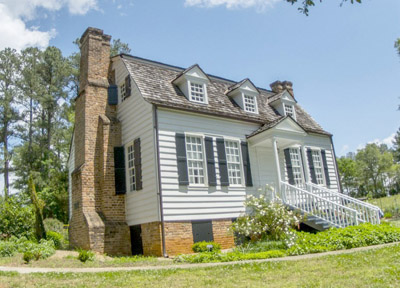Clemson to mark the 300th birthday of Hanover House
By: Ken Scar
Special to The Courier
news@thepccourier.com
CLEMSON — Clemson University will mark the 300th birthday of its oldest structural resident, Hanover House, with a public symposium featuring guest speakers from architecture and academics this Saturday, May 21 at the Strom Thurmond Institute on campus.
Speakers will include Dean Norton, director of horticulture at Mount Vernon; Patrick McMillan, director of the South Carolina Botanical Garden at Clemson; and Sally Reeves, co-author of the award-winning New Orleans Architecture series.

Ken Scar/Photo
Clemson University’s 300 year-old Hanover House sits on campus in the South Carolina Botanical Garden.
Hanover House, a white home built in the early 1700s in South Carolina’s Lowcountry, was saved from destruction and brought to the Clemson campus by faculty and students in 1941.
The preservation and refurbishment of Hanover House was a triumph for Clemson’s budding undergraduate research programs, said Will Hiott, Clemson’s director of historic properties.
“The historic preservation of Hanover House by architects and historians was in reality an early Creative Inquiry project involving students, faculty and staff to photograph, blueprint and document the structure on its original site in Berkeley County and to relocate and reconstruct Hanover on campus in 1941,” he said. “Much of the preservation and restoration work was overseen by faculty and staff.”
Hanover House was built in 1716 for French Huguenot Paul de St. Julien in what is now Berkeley County. It was planned as a three-story house made of bricks and cypress and was considered very luxurious at the time. The original design was simple, featured balanced symmetry, a gambrel roof, dormers, and French details. St. Julien honored his French heritage in the mortar of one chimney where he inscribed “Peu a Peu,” from the French proverb, “Little by little the bird builds its nest.”
The house remained in the St. Julien and Ravenel families for nearly 150 years. In the 1940s, progress threatened to destroy the home, as it was in the path of the man-made Lake Moultrie. The Historic American Buildings Survey of the Santee-Cooper basin noted that Hanover was of national significance. So, Hanover was moved 250 miles north to the campus of Clemson University, home to the state’s architecture school. It was relocated to the South Carolina Botanical Garden in 1994 and now overlooks an heirloom vegetable garden.
“We are excited to celebrate this milestone of three centuries of the colonial cottage. This year we observe not only the tricentennial of Hanover but also its 75th year as part of Clemson University,” Hiott said.
“Hanover is truly a gem of Colonial architecture, which was deemed nationally important,” he said. “As we reflect on the tricentennial of the Hanover, we reflect on American history and the Huguenots, like the St. Juliens and Ravenels, who came to the Colonies, fought in the American Revolution with Francis Marion and aided in founding South Carolina.”
To register for the daylong symposium, go to http://blogs.clemson.edu/hanover-300/2016/05/02/hanover-300th-registration-link/.



























